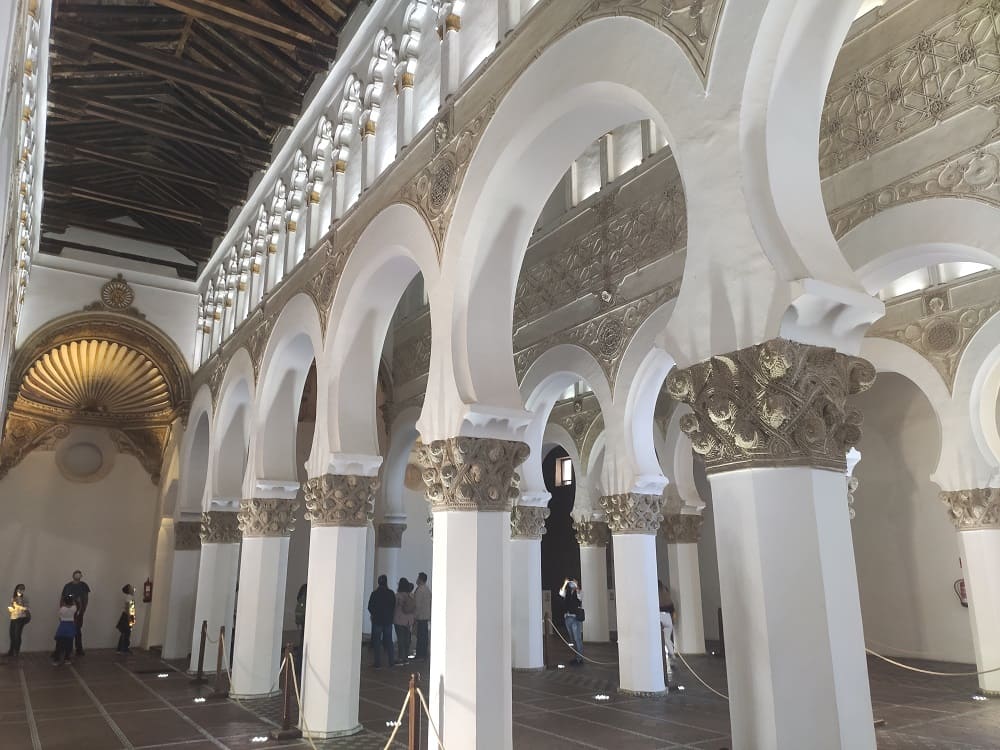
Since the fall of the Romans, different cultures have coexisted in Toledo and it is reflected in the mix of architecture whose predominant style is Mudejar, which adds Arabic to the previous Visigothic style of the peninsula. There are also the Greco-Roman seen on the walls, the mozalbete, an Arab style typical of the peninsula, the Plateresque, the fashionable style of Castile from the 16th century, the Gothic in religious constructions, the Neoclassical and the Baroque.
The clearest example of this diversity is the creation by Alfonso X (1252-1284), King of Castilla y León, of the Toledo School of Translators. Christians, Muslims and Jews collaborated in it, translating from Arabic into Latin and Spanish. The School was very important in the dissemination in the Peninsula and Europe of the scientific, philosophical and literary works of Greeks, Romans, Muslims and Jews.
The choice of the Santa María La Blanca synagogue in the blog image for this entire article and that we can see on the right, is not by chance since it is the best reflection of this mix between the three cultures. This synagogue was built by Arabs as a mosque and after the taking of the city it would be donated to the Jewish community who decorated the walls with Jewish details. When the expulsion took place, it would become a Christian church. Currently it is not a cult building and despite being owned by the church it is called a synagogue, being the second most important synagogue in the city.
In this section I will mention the most important Christian buildings in Toledo. In Toledo there are more than 100 churches, of which there are about 19 that are considered well of cultural interest. In addition, 18 convents also have this category of protection.
Also called the Cathedral of Santa María, it is a Catholic temple where Gothic architecture predominates. It is the third largest cathedral in Spain behind the cathedral of Seville and that of Palma de Mallorca.
Its construction would begin in 1226 and end around the 16th century. It would be erected on the Visigothic temple in the time of San Eugenio. Because Toledo was the capital of the Visigothic kingdom, it had the episcopal see. After the Arab invasion this temple would be converted into a mosque. Proof of fact is that several walls and columns would be preserved in the transformation to a cathedral. After centuries of Arab occupation, the reconquest would arrive and in 1085 an agreement was reached in the city for its peaceful capture. In it, it was promised that the buildings and cultures that existed in the city would be preserved, although for what it is today the cathedral was not fulfilled and was taken by force and turned into a church. Later there would be a pact between the Muslim and Catholic community and the Christian cult would remain, although there would be no changes in the building until the year 1222, when it would begin to reform completely. This transformation would be in the Gothic style of the time based on the Gothic of France, a country at that time defender of the faith of all Europe.
At the beginning of the 16th century, the cathedral would be completed, with the construction of the door of the lions and details of the Mozarabic chapel. The cathedral has only one tower since, because there was no gold to pay for, the second tower was built and it was sheltered with a dome as it remains today. From that century on, other elements such as several of the chapels, the sacristy and the chapter house would be built. All this would be under the styles of those times from Gothic to Baroque.
The cathedral has elements of high beauty that differentiate it from other cathedrals, such as the transparent , a work of Baroque art built in 1721 in the churrigeresque style. They are sculptures of great detail added to the wall, with marbles brought from Genoa, jasper and bronzes. Play with the light, to make the light pass through a hole towards the tabernacle.
Also the custody of gold, the most valuable of the cathedrals in Spain for its size and the gold it contains, being the first gold brought from America.
Chapel of the descent of the Virgin , on the floor of the cathedral, the place where the Virgin appeared to San Ildefonso.
Chapel of the Old Kings and the New Kings , where kings of Spain prior to the 15th century are buried. The graves are decorated with their coats of arms and have many details.
Sacristy with paintings throughout the room and painted frescoes. It also highlights the Chapter House with a golden coffered ceiling and images of all the Toledo cardinals that have ever existed.
Gothic cloister of large proportions that was erected where a market formerly existed. It has several paintings from the 15th and 16th century.
Mozarabic Chapel that was built from the 16th century to continue worshiping in this rite for the population of Toledo, which was still deeply Mozarabic. These were the Catholics who lived in Muslim times.
Custody of the cathedral , which is the most important object of the cathedral treasure. It is of archaic Gothic style and of great architectural beauty. At first it was carved in silver but at the end of the 16th century it was gilded to match the custody of the main altar, which is made of gilded wood. Its author is Enrique de Arfe and it was commissioned by Cardinal Cisneros.
This is the second most important religious building in Toledo and one of the most visited along with the cathedral and the fortress.
It was built in the 15th century by order of Isabel La Católica. In principle she wanted it to be a royal pantheon, but it would not be like that since in the end the Habsburg kings would be buried in El Escorial and the Catholic kings in the cathedral of Granada.
The style is Elizabethan Gothic like other cathedrals built in that same century such as Burgos, Segovia or Granada. This building would have a political and state use like El Escorial in which there would be a religious order in charge of maintaining it but not being a monastery of monks' life like many others. The cloister and part of the building would be made by the architect Juan Guas and the cloister stands out above all, with extensive details in its columns, vaults and arches with a lot of iconography and decoration, as well as leaving space for sculptures and paintings. Also the coffered ceilings that are polychrome and Mudejar style. They have been restored and are like new.
The church has a political character due to the fact that it is full of symbols of the Catholic Monarchs and several coats of arms appear. Where the monarchy is linked with the divine.
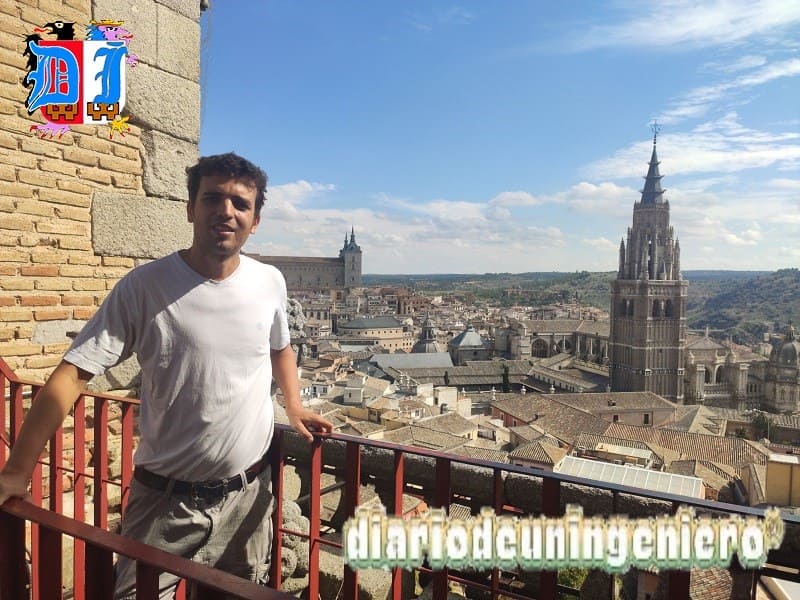
En Toledo existen multitud de iglesias destacando 19 de ellas como BIC (Bien de Interés Cultural), de las cuales 4 son de estilo mozárabe. Antiguas mezquitas convertidas en iglesias como son la iglesia de san Lucas, la iglesia de santa Eulalia y la iglesia de santa Justa y Rufina. He marcado en verde en los botones aquellas que conservan la planta de mezquita si bien algunas fueron levantadas sobre mezquitas. Estas mezquitas también en muchos casos fueron levantadas sobre templos cristianos visigodos y en algún caso sobre edificios romanos existentes.
The most recommended church to visit is that of San Ildefonso, which apart from the great altar that it has, you can climb the two towers where you have the best views of the Cathedral and the city from all angles, being able to go up to the roof on a platform that There is as I show in the picture.
Toledo is the most important diocese in Spain, with the whole of Castilla La Mancha as a subdiocese. In the 19th century the diocese of Toledo occupied a large area, belonging to the same present-day Castilla La Mancha, Murcia, Córdoba, Jaen, and Castilla La Vieja except for Burgos. The dioceses that existed were 8, Tarragona (Catalonia), Valencia (Levante), Seville (western Andalusia and the Canary Islands), Granada (Granada and Almería), Santiago (Galicia, el Bierzo. Zamora, Salamanca and Extremadura), León (Oviedo and Leon), Burgos (Burgos, Cantabria, the Basque Country and Navarra) and Zaragoza (now Aragon).
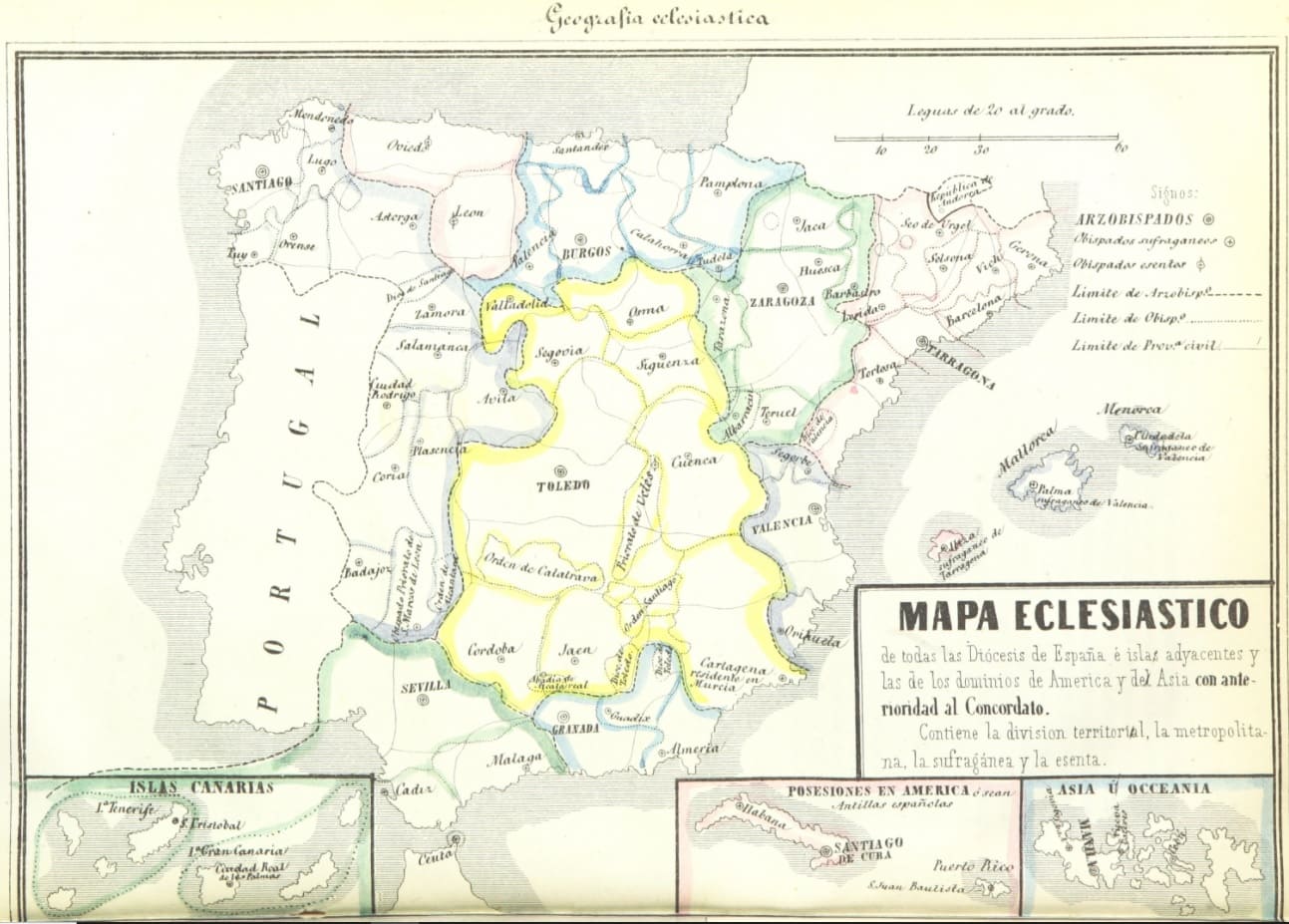
The number of convents in Toledo is very large, occupying a large area of the historic center. Other cities had in their time a similar number of convents where most of the religious orders were represented, but Toledo has maintained those orders within the city. This is because the importance of Toledo as a union of the church in Spain has been maintained since the 6th century, date in which the Visigoths named Toledo as the capital of Spain, becoming the most important city being with the Romans Cartagena, that it was the capital of the Carthaginians, who were the first people to have a large domain in the Iberian Peninsula and connect different peoples with each other.
I have shown the 19 convents of Toledo with the category of Asset of Cultural Interest. Most of it is still inhabited by nuns who do a very large social work in the province of Toledo. They also tend to sell pastries and sweets as one of the means to continue maintaining the buildings, although without the help of the church and the state that money would not be enough to restore and maintain most of the buildings.
Apart from convents and churches there are some interesting hermitages, highlighting that of Cristo de la Vega. Although there are more such as the Nuestra Señora de la Estrella, the San Eugenia, the Virgen de la Cabeza hermitage, the Bastida hermitage, the Virgen de los Desamparados hermitage, the San Jerónimo hermitage, the hermitage of San Roque and the hermitage of Valle.
Arab architecture is all over Toledo, since the Mudejar has many elements of this architecture. Properly it would be more notable where the Arab quarter was located before its expulsion by the Catholic Monarchs. This neighborhood was at the entrance of Toledo from the Puerta de la Bisagra, in the northwestern part of the city, where the church of Santiago del Arrabal and the Mosque of Light that I will now describe are located.
This mosque is the oldest building in Toledo that is preserved in its entirety. It is also the only mosque named as such together with the Tornerías mosque , since the other mosques were converted into churches and were remodeled. These other 7 are, the Primada cathedral that was a mosque before a cathedral , and was also the largest mosque in Toledo, the church of El Salvador, which have also discovered parts of the previous building in Recent excavations that can be visited, the church of San Sebastián, that of Santa Justa and Rufina, that of San Andrés and Cipriano, that of San Lorenzo (destroyed inside in a fire) and that of San Roman . In 4 of them, mass continues with the Hispano-Mozarabic rite.
But there were more than 9 what happens is that those that were built on the mosques disappeared. Mosques are those that have the yellow button in the churches section, in addition to the cathedral. The apse was added as early as the 12th century, after the taking of the city and is clearly Mudejar, like almost the entire city. The mosque is of Visigothic origin, and there was surely a temple dedicated to a Roman god before that. This building is unique in the peninsula for having been made in brick almost entirely by the Arabs and has elements similar to other mosques of that time in Spanish territory such as Córdoba and the Alhambra.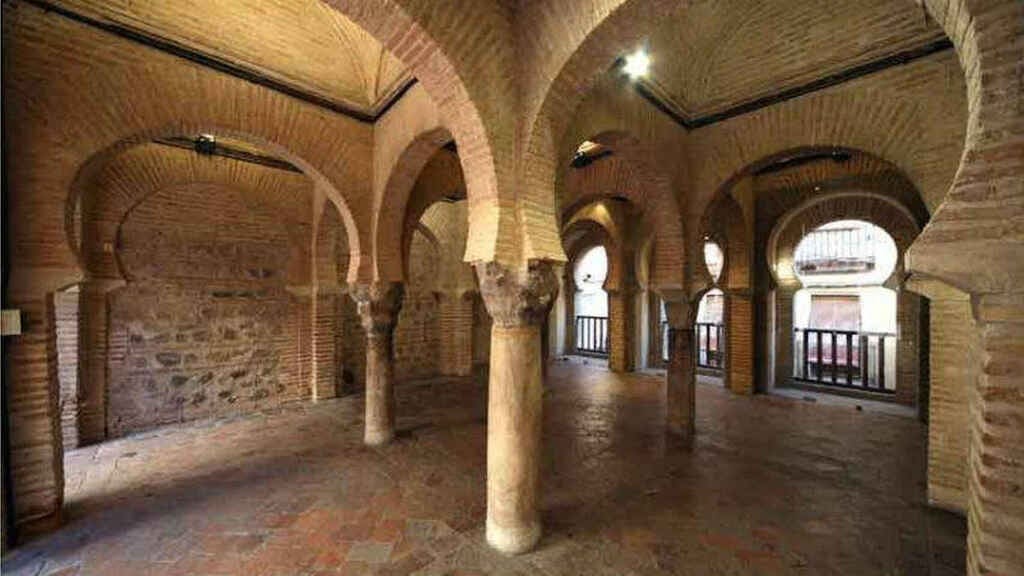
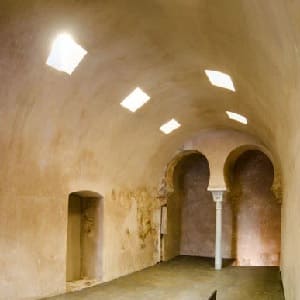 Además es bien de interés cultural la Mezquita de Tornerías, recientemente restaurada. Fue construida a mitad del siglo XI y esta ubicada en el lo que fue el zoco comercial árabe.
Además es bien de interés cultural la Mezquita de Tornerías, recientemente restaurada. Fue construida a mitad del siglo XI y esta ubicada en el lo que fue el zoco comercial árabe. 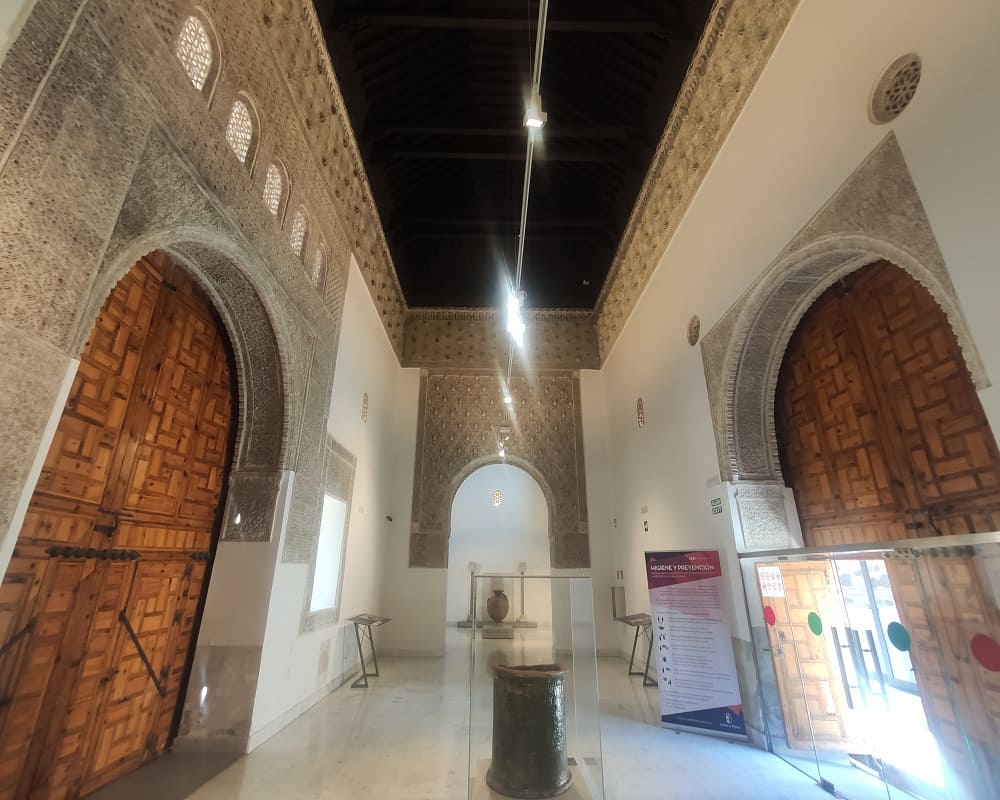
The Jewish quarter is located to the west of the city. From the Cambron gate to the river. In this neighborhood we have two of the synagogues that still remain out of the 13 that existed in the city. In the Jewish quarter there are tiles with symbols associated with Jewish culture, with the aim of delimiting the area it occupied.
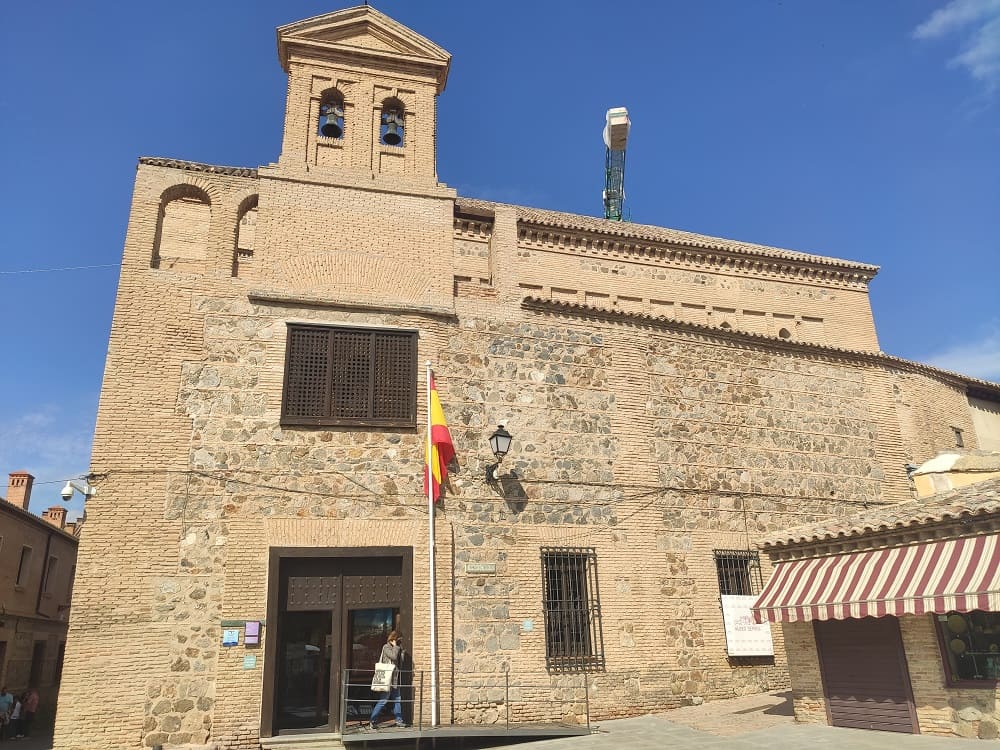
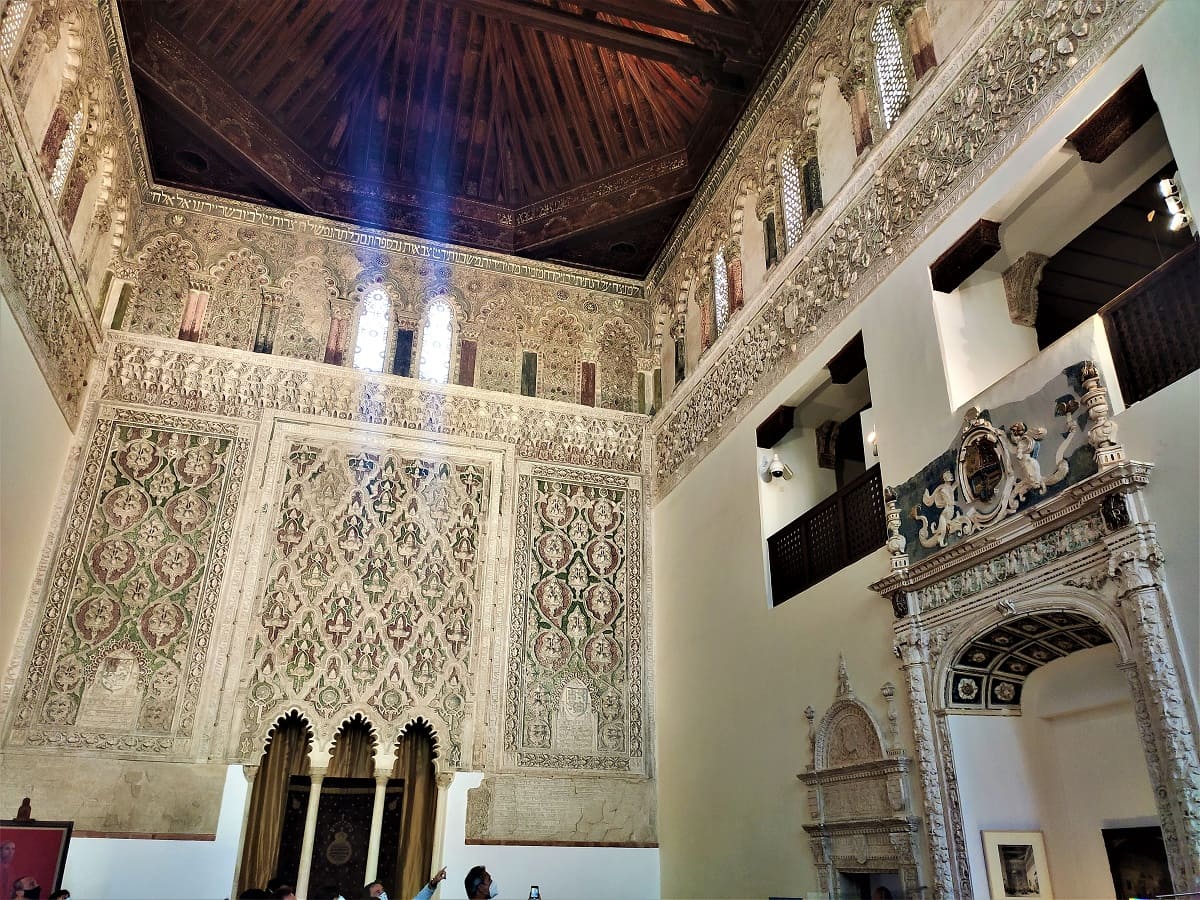
Fue construida entre los siglos XIV y XV. El exterior es mudejar como otras construcciones y dentro actualmente se encuentra el museo sefardí ya que no hay culto judío en la ciudad de Toledo desde la expulsión por Los Reyes Católicos en 1411.
Since then, it has been used as a refuge for Penance, as a hermitage, as a barracks and as a military warehouse.
It maintains the original polychrome ceilings made by Arab carpenters and the decoration of plasterwork on the walls with words and texts in Hebrew.
And I end as I began by talking about this building, which was first a mosque, to then pass to the Jewish community and be returned to the Christian community after its expulsion. It has elements of the three religions, the plant being completely a mosque. Due to the cleaning of its walls carried out after its restoration and the lighting it has, it can be seen in great detail.
© 2016 - All Rights Reserved - Diseñada por Sergio López Martínez